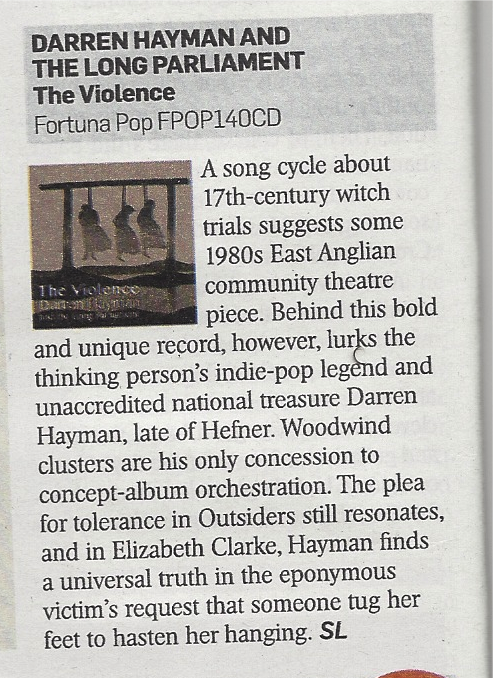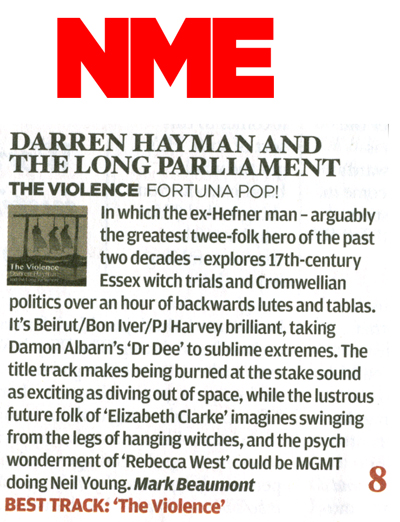I like this podcast/interview with Alexis Petridis on the Guardian Music Weekly. It starts around 34 mins in.
Category: The Violence Related
The Violence – Further reading suggestions
When putting the sleeve notes together for the violence I gave a lot of thought to including a bibliography. It would be absolutely necessary on a book but seemed a little pompous on a record.
However a few people have asked me what they should read to find out more so I thought I’d put a few of the main texts here.
These are the books I read in full. Other books were required for certain chapters and details but these ones informed the general vision.

God’s Fury, England’s Fire: A New History of the English Civil Wars
by Michael Braddick
Allen Lane
This book is exhaustive and a tough read but is excellent at throwing the 17th Century into context. It spends a lot of time explaining how local government worked for instance.
I found it interesting that, even though I would assume news trickled down to the people slowly, actually there were very few tiers between the beggar and the king.
The title is correct in using the plural as well. We should really always be referring to the English Civil WARS.

The English Civil War: A People’s History
By Diane Purkiss
Harper Collins
This a fantastic book. It’s where I discovered a lot of the themes and even some of the characters found in The Violence. If you were to read just one of these books I would suggest this one. It works hard to make the times personal and tells the story via letters and first person accounts.
It really explains well this fear of the ungodly and the chapter on Matthew Hopkins is one of the best written accounts.
This book is also where I discovered ‘Parliament Joan.’
Witchfinders: A Seventeenth-Century English Tragedy
by Malcolm Gaskill
John Murray
This is adequate as an overview of the witch trials and certainly helped me get events in the right order. The problem is that the author seems to enjoy the subject a little too much.
There’s plenty of accounts about imps and teets (he LOVES the word teets) but little about the reasons for what made the phenomenon come about.
In particular I wanted to found out more about the women who openly confessed and believed themselves to be witches. Something I never got to deal with fully on my record either.
The book was perhaps most helpful in showing me a way I didn’t want to pursue.
The Witchfiner and the Devil’s Darlings
By Simone Peters
Lucas Books
Once again, the title suggests some of the frivolity found within, though in fact its a little drier than the Gaskill book. Includes some interesting song lyrics from the time that will appear on a soon to come companion album of English Civil War folk songs.
The Witch in History: Early Modern and Twentieth-Century Representations.
Diane Purkiss
Routledge
Second entry in the bibliography for the excellent Purkiss. Some of the research is used to give you an overview if not inform specific songs. This book was pivotal in perhaps showing me what tropes to avoid in Witch folk lore.
Historical and Political Ballads and Songs of the Stuart Era
Chris Bennett
A self published book which helped with some of the folk instrumentals on the album and also the sister album of 17th century folk songs that is soon to be released.

The Lore of the Land: A Guide to England’s Legends, from Spring-heeled Jack to the Witches of Warboys
by Jennifer Westwood and Jacqueline Simpson
Penguin
An excellent book which gave me more ideas then I could ever put in to the Violence. I really wanted to do something about the Cunning Men, male ‘witches’ from the Hadleigh area of Essex. Especially as it tied in with the geography of Essex Arms.

A Calendar of Country Customs
Ralph Whitlock
There is only one out take from the Violence, a song called Queen of Misrule which is a close cousin to ‘The Christmas Wars’ on last years Christmas EP. I tried hard but constantly failed to write about Cromwell’s banning of Christmas and the so called ‘wars’ that surrounded them.
Some of the details came from this book.
Sunday Times review from Stewart Lee

NME Review 8/10

Video – The Making of the Violence Part 2
Desire Lines -Free Download from The Violence
The Making of The Violence Part 1 – The Video
The Violence – Uncut Review

Stool Pigeon Review

Impossible Times (alternate video) – Darren Hayman
Taken from The Violence released 5th November


